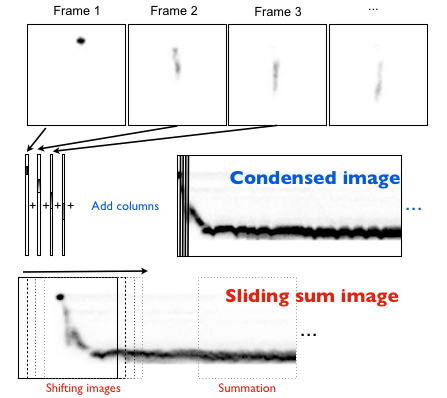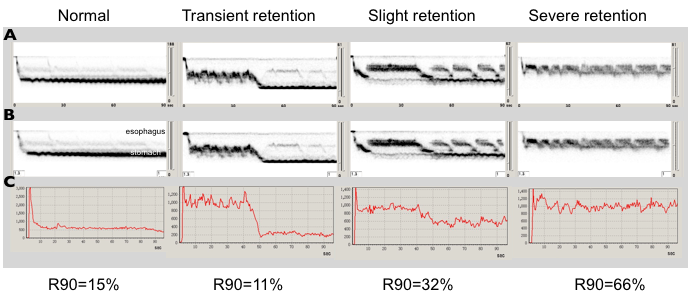教室紹介Works
食道シンチグラフィ(食道通過検査)の解析ソフトウェアの提供
New Software Algorithm for Esophageal Transit Study
Dynamic esophageal transit scintigraphy is a diagnostic procedure to evaluate esophageal functional abnormalities of motility or peristalsis.The analysis of condensed images has been used. Each frame was compressed to a single column, and the columns were assembled into a condensed image, whose horizontal and vertical directions included temporal and spatial dimensions.
In this study we proposed simple algorithm of "sliding sum image" for comparable but simpler and rapid algorithm.
Sliding sum image of the espophageal transit
In the sliding sum image presented in this study, serial dynamic images are horizontally shifted rightwards by n pixels (n=1 to the last image number), and they are added in the final image. Because of the processing of simple image shifting and summation, the processing time for creating summed image is <1 sec and completely operator independent.
Method of esophageal transit study
The esophageal transit study is performed under fasting condition for at least 6 h. Tc-99m DTPA is mixed with a semi-liquid enteral feeding formula Racol* is used in our hospital.
Patients are instructed to retain 7-10 mL in their mouth, in which 10 MBq of Tc-99m is mixed, and to swallow it in one gulp. After 30 seconds, the patients repeate dry swallows during each 15-second interval. Serial anterior images were acquired in 64 x 64 matrices for 96 s at 0.5 seconds per frame.
*Otsuka Pharmaceutical Company, Ltd, Japan (200 kcal with 8.76 g of protein, 4.46 g of lipids, and 31.24 g of carbohydrates)
Typical transit patterns
Four patterns of normal, transient retention, slight retention and severe retention patterns are observed, depending on the severity of esophageal transit.
A time activity curve (TAC) is gernerated using a region of interest over the whole esophagus. Retention fraction at 90 seconds (R90) is calculated by the TAC.
Applicatio to patients with systemic sclerosis is shown in the references.

| pattern | Condensed and sliding image patterns, TAC |
|---|---|
| normal transit pattern |
|
| transient retention pattern |
|
| slight retention pattern |
|
| severe retention pattern |
|

References
To take contact and reprint request, mail to nakajima@med.kanazawa-u.ac.jp . The software "ESOP" is available for PC version (Windows). The esophageal dynamic study of DICOM format will be easily transferred and processed by this software. For software information, send e mail to the address above.
- Nakajima K, Hasegawa M, Inaki A, Wakabayashi H, Hosoya T, Takehara K, Kinuya S. Esophageal transit study using a sliding sum image: application to patients with probable and definite systemic sclerosis Ann Nucl Med (2011) 25:325-331[pubmed]
- Nakajima K, Inaki A, Hiramatsu T, Hasegawa M, Fujimoto M, Takehara K, et al. Esophageal transit scintigraphy and structured questionnaire in patients with systemic sclerosis with endoscopically proven reflux esophagitis. Ann Nucl Med. 2009;23:771-6. [Springer][pubmed]
- Nakajima K, Kawano M, Kinuya K, Sato S, Takehara K, Tonami N. The diagnostic value of oesophageal transit scintigraphy for evaluating the severity of oesophageal complications in systemic sclerosis. Nucl Med Commun. 2004; 25:375-81[pubmed]
